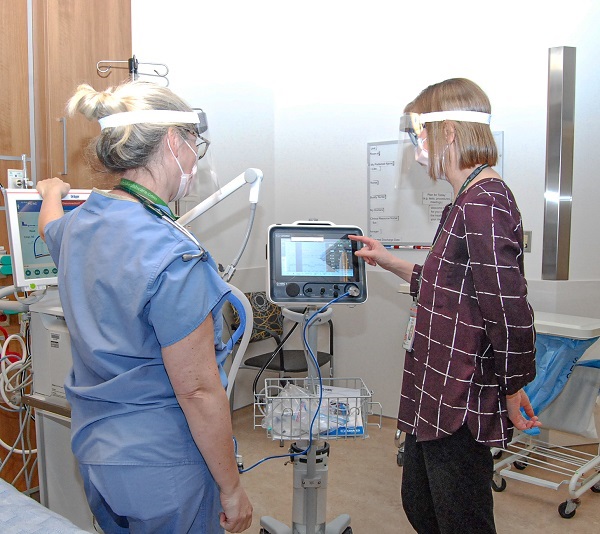Assessing the nutritional needs of critically ill patients is an ongoing challenge for dietitians. To support meeting the caloric needs of these individuals, Halton Healthcare’s Oakville Trafalgar Memorial Hospital (OTMH) is pleased to be the first hospital in Ontario to be home to a Q-NRG+ Indirect Calorimeter machine. The machine uses new technology to measure oxygen and carbon dioxide levels in patients’ breath to determine their resting energy expenditure (REE).
“The Indirect Calorimetry is a new method to assess a critically ill patient’s nutrition needs, and give us the information we need to create individualized nutrition care plans for people in the Intensive Care Unit. The needs of these individuals are very different than of other patients,” says Hilda Seyler, Dietitian, Halton Healthcare.
Before the Indirect Calorimetry (IC) device was introduced at Halton Healthcare, the practice was to use predictive equations based on age, weight, height and gender.
“The Q-NRG+ gives me more confidence that the nutrition I’m recommending is accurate and individualized to the patient, because we’re using real-time measurements,” adds Seyler.
Older models of IC devices are typically big and time consuming, usually taking more than an hour to calculate results. Tina Stewart, Clinical Nutrition Manager, says the major benefit of the Q-NRG+ Indirect Calorimeter is that it’s portable and quick. “It only takes 10 to 15 minutes to collect the necessary data, so it’s quite efficient,” she says. “It’s also just slightly larger than a blood pressure machine, and easily mobile.”
The adoption of the Q-NRG+ device has offered a unique connection across teams within Halton Healthcare. Thanks to the collaborative efforts of Dietitians and Respiratory Therapists (RTs), the machine has been successfully integrated into both their practices. With the RTs calibrating the device and using it to measure a patient’s oxygen intake and Dietitians using the calorimeter’s readings to measure the nutrition needs of the patient.
“The Q-NRG+ is very easy to use, very accurate and doesn’t disrupt the clinicians on either side. We RTs are used to ventilators and this machine uses parts similar to what a ventilator uses to measure flow. It’s been a very easy and valuable tool for everyone to use,” explains Margaret Coburn, Respiratory Therapist, Halton Healthcare.
“For acute care this is a great device to have, especially in light of the pandemic, with some patients being ventilated longer,” says Coburn. “This definitely helps us provide better care to our patients because we can fine tune to their individual needs.”
The Q-NRG+ is currently integrated as a patient care option in the OTMH Intensive Care Unit and can be used on any critically ill patient.
The device was purchased through Halton Healthcare’s Innovation Grant, which is an organizational initiative that supports innovative ideas by staff, physicians and volunteers to advance patient care. Halton Healthcare introduced the Innovation Grant program in 2017 and to date has invested approximately $612,000 in more than 70 staff-led initiatives.


